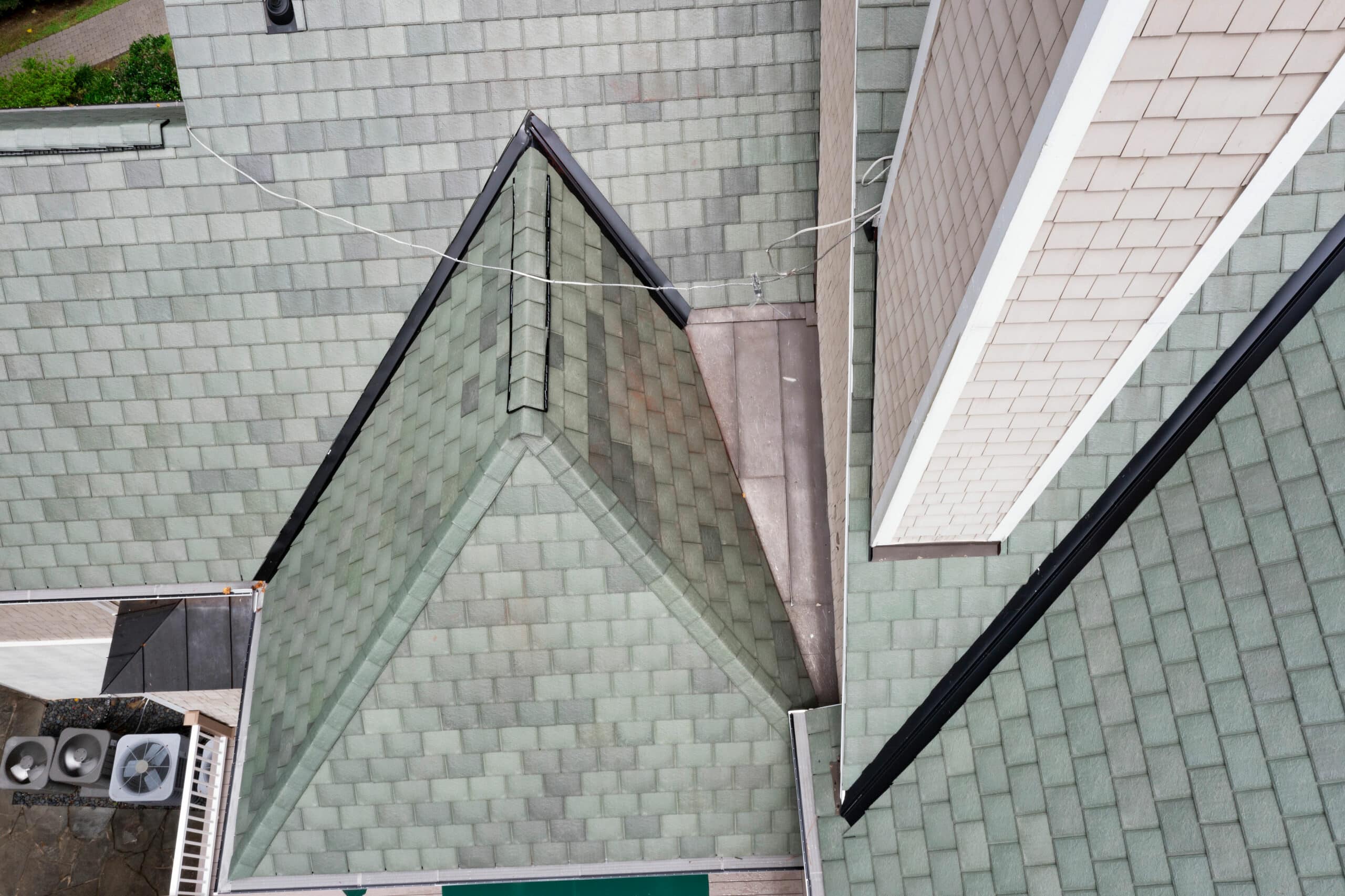
When it’s time to replace your roof, the choices can feel a bit… uninspiring. You’ve got the standard asphalt shingle everyone has, or the (often very loud) metal option. It feels like you’re settling for “good enough” or “too expensive.”
What if you could get the stunning, high-end look of natural slate or classic cedar shake without the budget-breaking price tag and constant maintenance headaches?
That’s the secret behind the composite roof. This material is the chameleon of the roofing world, blending high-end aesthetics with serious, high-tech durability. It’s quickly becoming the go-to choice for smart Atlanta homeowners who want curb appeal that lasts.
So, what exactly is this stuff, and could it be the right fit for your home?
What Is a Composite Roof?
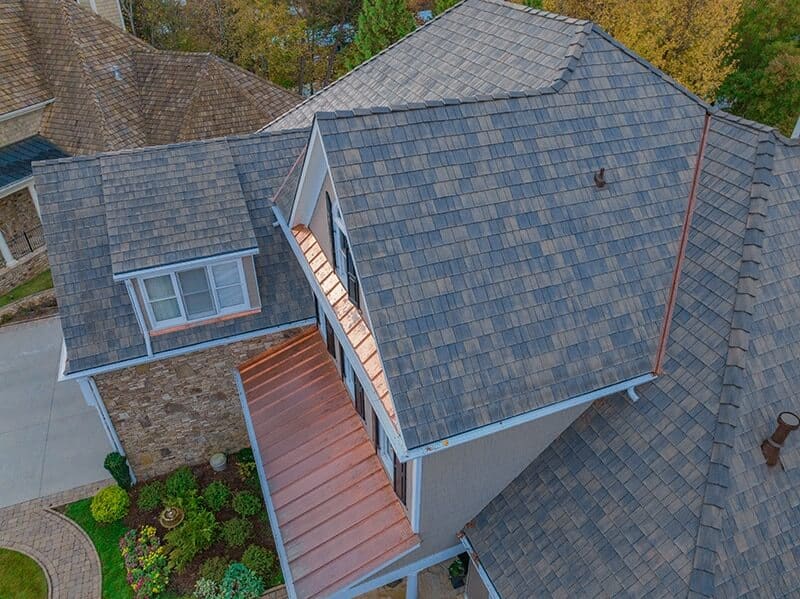
A composite roof is a modern roofing solution made from a carefully engineered mix of asphalt, fiberglass, recycled plastics, and other polymers
This blend of materials creates stronger, more affordable, and weather-resistant roofs that mimic the appearance of high-end roofs made from materials like slate, cedar, or clay.
Composite roofs come in various forms, including composite roof shingles, composite roof tiles, and composite slate roof tiles, giving homeowners a wide range of design options.
Why Homeowners in Atlanta and North Georgia Choose Composite Roofing
Homeowners in Atlanta, Marietta, Alpharetta, and surrounding areas are increasingly turning to composite roofs for a mix of practical and aesthetic reasons:
| Reason | Description |
| Adaptable to Local Climate | Composite materials handle Georgia’s hot summers, high humidity, and seasonal storms with ease. |
| Low Maintenance | Unlike wood or slate, composite roofs rarely require extensive upkeep, making them perfect for busy homeowners. |
| Longevity | A well-installed composite shingle roof or composite slate roof can last decades with minimal issues. |
In short, a composite roof offers the beauty of traditional roofing materials with modern engineering that stands up to the demands of North Georgia weather. Whether you’re considering composite roof installation or a composite shingle roof repair, these roofs provide both peace of mind and curb appeal.
Types of Composite Roofs
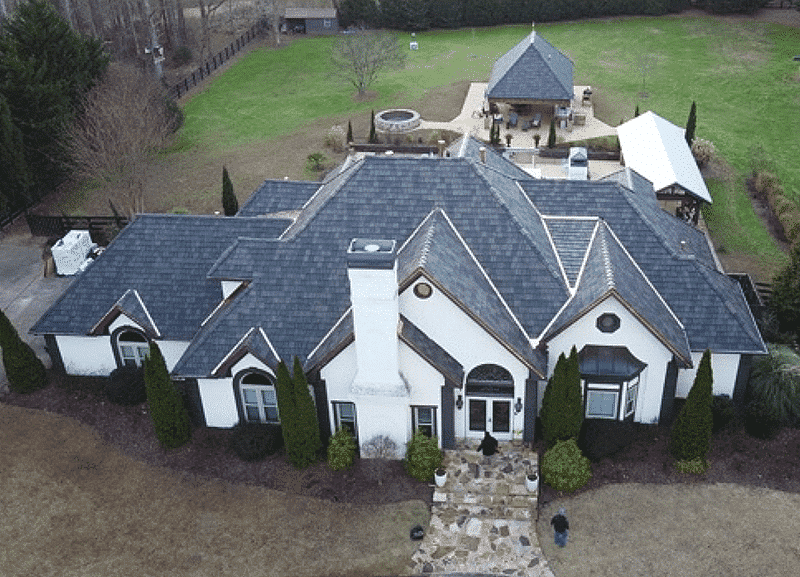
Depending on the look that you’re going for with your roof, you’ll want to choose a specific type of composite roof product. Here are the differences between the different types clearly laid out, so it’s easy to understand what product corresponds to which look.
Quick Comparison Table
| Roofing Term | What It Refers To | Style Options | Price Level | Best For |
| Composite Roof Shingles | Synthetic shingles | Slate-look, shake-look, asphalt-look | $$ | Affordable composite upgrade |
| Composite Roof Tiles | Tile-shaped panels that are larger and thicker than traditional tiles | Slate, shake, Spanish tile | $$$-$$$$ | High-end appearance & durability |
| Composite Slate Roof | Synthetic slate tiles or shingles | Imitation slate, polymer slate | $$$-$$$$ | Luxury slate look without weight |
| Composite Cedar Shake Roof | Synthetic cedar shakes | Hand-split, heavy shake | $$$-$$$$ | Rustic cedar look with low maintenance |
1. Composite Roof Shingles
These are individual shingle panels designed to look like traditional asphalt shingles, cedar shake, or slate, but made from engineered materials like polymers, recycled plastics, and rubber.
Key Traits:
- Smaller pieces (similar to asphalt shingles)
- Lightweight and easy to install
- Often installed in overlapping rows
- Affordable compared to composite tiles
Overall, composite roof shingles are the best option for homeowners who want a durable, upgraded version of asphalt shingles with better longevity and curb appeal.
Composite Roof Shingles vs. Traditional Roof Shingles
| Feature | Composite Roof Shingles | Traditional Shingles (Asphalt, Cedar, Clay, Slate) |
| Durability | Highly resistant to cracking, curling, warping, and fading | Varies: asphalt can crack/curl; cedar can rot; clay/slate can break |
| Weather Resistance | Excellent in heavy rain, high winds, hail, and UV exposure | Asphalt has moderate resistance; cedar absorbs moisture; clay/slate resist weather, but can be brittle |
| Lifespan | 40-50+ years | Asphalt: 15-30 yrs Cedar: 20-30 yrs Clay/Slate: 50-100 yrs, but fragile & heavy |
| Maintenance | Very low; no rot or mold issues | Cedar requires regular upkeep; asphalt needs periodic repairs; clay/slate needs specialist care |
| Weight | Lightweight; works on most homes without reinforcement | Clay/slate is extremely heavy; may require structural support |
| Appearance Options | Can mimic cedar shake, slate, or clay with realistic textures | Asphalt is limited in style; cedar, clay, and slate have natural aesthetics |
| Eco-Friendliness | Often made from recycled or recyclable materials | Asphalt is petroleum-based; cedar involves wood harvesting; clay/slate are natural but energy-intensive |
| Cost | Higher upfront but lower long-term maintenance | Asphalt is the cheapest; cedar, clay, and slate can be high-cost depending on type |
| Impact Resistance | High impact ratings (Class 4 options available) | Asphalt offers lower impact resistance; clay/slate can crack on impact |
| Fire Resistance | Typically Class A fire-rated | Cedar can be combustible; asphalt is Class A; clay/slate is naturally fireproof |
2. Composite Roof Tiles
These tiles are larger, thicker, and shaped like traditional roof tiles, so you can achieve a similar look to another type of tile (e.g., cedar, Spanish, barrel, etc.) with the benefit of added durability.
Key Traits:
- Tile-style design (flat slate tile, shake tile, barrel tile)
- Creates a more authentic high-end look
- More dimension and depth than traditional shingles
- Longer-lasting but more premium in price
Overall, composite roof tiles are perfect for homeowners wanting the look of slate, shake, or Spanish tile without the weight, cost, or maintenance.
3. Composite Slate Roof
A composite slate roof is made from synthetic slate tiles or shingles—products that mimic natural slate stone.
Key Traits:
- Designed to replicate real slate texture and color
- Much lighter than real slate (no structural reinforcement needed)
- Resistant to cracking, impact, and weather
- Premium curb appeal
These tiles are best for homeowners who want a luxury slate tile appearance but don’t want the structural weight of natural stone.
4. Composite Cedar Shake Roof
This is a roof built with synthetic cedar shake tiles/shingles that imitate real hand-split or machine-sawn cedar shakes.
Key Traits:
- Replicates the rustic look of cedar shake roofing
- Won’t rot, split, or develop mold like real wood
- More fire-resistant than natural cedar
- Comes in multiple profiles for authentic texture
Composite “cedar shake” roofs are a great choice for homeowners who love the warm, natural cedar look but want far better durability and weather resistance than real wood.
Composite Roof Brands
When you’re choosing a composite or synthetic roofing system in Atlanta, Marietta, Alpharetta, or the surrounding areas, it helps to understand the major brands on the market. Each brand offers its own strengths in durability, style, and weather performance. Here’s a quick breakdown to help you compare your options:
| Brand | Primary Styles | Key Strengths | Best For Homeowners Who Want… |
| DaVinci Roofscapes | Slate, Cedar Shake | Ultra-realistic appearance, Class A fire rating, Class 4 impact resistance, long lifespan | A premium, luxury look with the strongest weather performance |
| Enviroshake | Cedar Shake, Slate | UV stability, mold/mildew resistance, made from recycled materials | A low-maintenance shake/slate alternative ideal for heat & humidity |
| Brava Roof Tile | Cedar Shake, Slate, Clay/Spanish Tile | Highly detailed textures, unlimited color blends, lightweight tiles | Authentic shake, tile, or slate designs without structural reinforcement |
How Long Does a Composite Roof Last?
The composite roof lifespan is one of its single greatest advantages. While a standard architectural asphalt shingle roof gives you about 20-25 years (if you’re lucky and the storms stay away), a properly installed composite roof is built for the long haul.
You can typically expect a 40 to 50-year lifespan from a quality composite shingle, slate, or tile roof.
What Makes a Composite Roof Actually Last 50 Years?
A 50-year warranty is fantastic, but it’s not automatic. A roof’s real-world lifespan depends entirely on the quality of the complete system. You can’t just slap new shingles on and expect them to last.
Even the best roofing material needs proper support to reach its full lifespan. Key factors include:
| Factors | Description |
| Installation Quality | A roofer who rushes the job, uses the wrong number of fasteners, or improperly installs the flashing around your chimney can cut the life of a 50-year roof in half. |
| Maintenance | While a composite roof is low-maintenance, it’s not no-maintenance. A yearly inspection (like the kind Mr. Roofer provides) ensures that any minor issues with flashing or sealant are caught before they become major leaks. |
| Proper Attic Ventilation | This is the big one that most roofers ignore. Your roof needs to breathe. In our hot, humid climate, an improperly ventilated attic becomes a trap for heat and moisture. |
- In Summer: Trapped, super-heated air (which can reach 150°F) literally bakes your shingles from the inside out, causing them to become brittle.
- In Winter: Warm, moist air from your home rises and condenses on the cold underside of the roof deck, leading to wood rot, mold, and a spongy, failing roof structure.
This is why we don’t just sell shingles, but we install a complete roofing system. The right underlayment (which acts as a final waterproof barrier) and a precisely balanced attic ventilation system are non-negotiable. They are the essential components that ensure your composite roof installation will actually protect your home for the next half-century.
Composite Roof Cost Breakdown
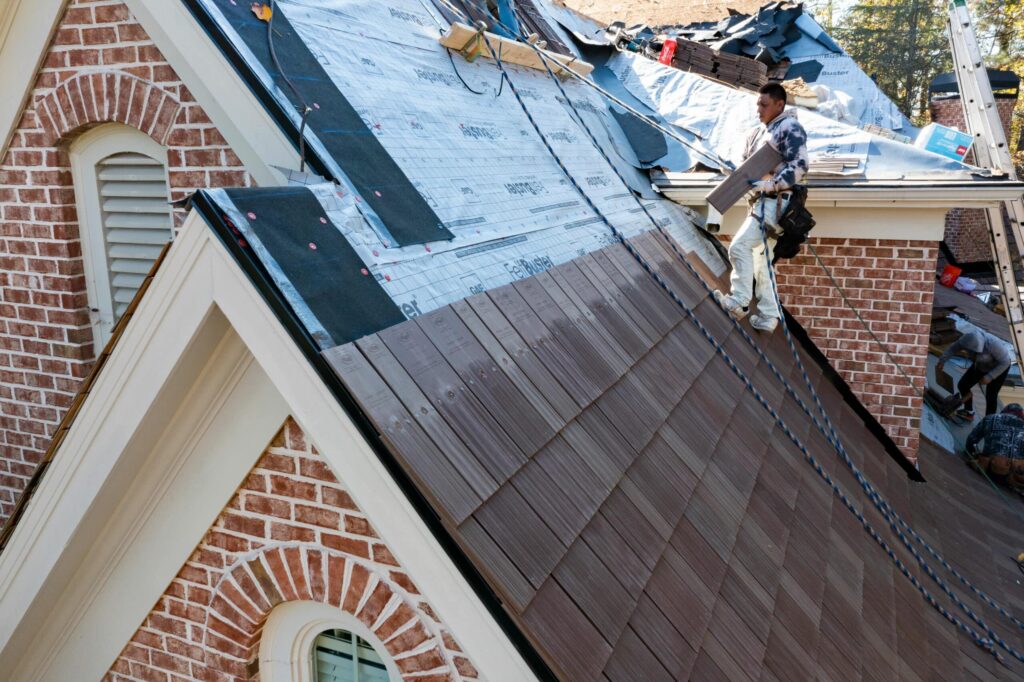
This is where we get down to brass tacks. A composite roof is a premium, high-performance product, and its price reflects that.
Viewing it as a long-term investment rather than a simple expense is key. The composite shingle roof cost is higher upfront, but the value is realized over its 50-year lifespan.
Average Composite Shingle Roof Cost
In Atlanta, Marietta, Alpharetta, and nearby North Georgia cities, the average cost of a composite shingle roof typically ranges from $9 to $16 per square foot, depending on the product line, roof structure, and installation requirements. Premium options like composite slate or composite cedar shakes can run higher because of their thickness, profile, and enhanced performance ratings.
Industry estimates place composite roofing materials between $400 and $1,200 per square (100 sq. ft.), often higher for wood-shake or slate-style synthetic materials. Labor generally adds another $300 to $600 per square, depending on steepness and complexity.
Because composite materials are lightweight compared to slate or tile, they often reduce structural reinforcement costs, which offsets some of the material expense.
Cost Per Square Foot: Material vs Labor
You can break down typical costs like this:
- Material Costs (per sq ft):
- Composite shingles: $4-$10
- Composite roof tiles: $6-$12
- Composite slate roof tiles: $8-$14
- Composite cedar shake roof: $9-$16
- Labor Costs (per sq ft):
- Standard roofs: $3-$6
- Steep or complex roofs: $6-$10
Labor pricing varies because composite roofing requires precision installation to achieve its full longevity, especially with heavier profiles like multi-width cedar shake styles.
How Roof Pitch, Size, and Complexity Affect Cost
Several factors influence what homeowners pay for composite roof shingles or composite roof tiles:
- Roof Pitch: Steeper roofs require harnesses, more labor, and more time.
- Roof Size: Larger roofs naturally increase both material and labor totals.
- Complexity: Valleys, skylights, chimneys, and multi-level rooflines add labor intensity and require additional flashing work.
- Material Style: Composite slate and cedar shake profiles cost more than traditional architectural composite shingles.
These elements are especially important in North Georgia neighborhoods where many homes have multi-hip roofs or steep gables.
Composite Roof vs. Asphalt
Price comparison:
- Asphalt shingles: $4-$8 per sq ft installed
- Composite shingles: $9-$16 per sq ft installed
While asphalt is cheaper upfront, its shorter lifespan means that most homeowners will replace it twice before they’d ever need to replace a composite roof. Asphalt also breaks down faster in Southern heat due to granule loss and UV exposure.
Energy Efficiency & Heat Reflection
Many composite roofing systems include reflective pigments or engineered surface layers that perform better in hot climates. Some products achieve cool roof ratings, helping:
- Reduce attic heat
- Lower HVAC strain
- Improve year-round energy efficiency
Composite tiles also don’t absorb heat the way asphalt granules do, which helps extend roof life and reduce temperature extremes.
Long-Term Savings with Composite Materials
Long-term financial benefits include:
- Fewer roof replacements over a 40-50 year span
- Lower repair frequency thanks to impact resistance
- Insurance discounts for Class 4 impact-rated materials
- Potential energy savings depending on product choice
Homeowners in Georgia also save on maintenance because composite roofs don’t rot, crack, mold, or warp, reducing lifetime repair costs significantly.
Metal Roof vs. Composite
This is a closer battle, as both are high-performance, long-lasting “investment-grade” roofs. The metal vs. composite roof pros and cons often come down to cost and aesthetics.
Metal Roof Advantages:
- Extremely long lifespan: 50-70 years
- Reflective and energy efficient
- Very strong against wind and fire
- Modern, sleek look
Metal Roof Drawbacks:
- Higher upfront cost
- Noise during heavy rain or hail (unless insulated)
- Can dent from large hail
- Limited style options
Composite Roof Advantages:
- Wide aesthetic range: slate, cedar, shake, tile, shingle
- More budget-friendly than premium metals
- Very quiet during storms
- Thick profiles add curb appeal
- Long lifespan: 40-50 years
- Excellent impact resistance
Composite Drawbacks:
- Not as recyclable as metal
- Premium profiles can approach metal pricing
When it comes to aesthetics, metal roofing leans modern or industrial. Composite roofing offers the opposite:
- traditional
- rustic
- Mediterranean
- high-end slate aesthetics
From composite cedar shake roofs to composite Spanish roof tiles, homeowners have far more flexibility in matching architectural style without sacrificing durability.
Which Offers Better ROI?
Both offer a fantastic return on investment. The metal vs. composite roof cost debate is tight, but composite often wins on flexibility.
A metal roof is a very specific look that doesn’t fit every home’s style. A composite roof gives you the same 50-year-plus performance while allowing you to achieve the timeless, high-end look of a composite slate roof in Alpharetta or a rustic composite cedar shake roof in Marietta, adding immense curb appeal that a metal roof can’t always match.
Installation: How a Composite Roof Is Installed
A proper composite roof installation is a precise, multi-step process that creates a complete, integrated system to protect your home.
Composite Roof Installation Steps
Here’s a simplified look at how a professional, certified team (like ours at Mr. Roofer) handles the job:
- Full Tear-Off and Deck Inspection: The old roof is completely removed down to the wood decking. This allows us to perform a critical inspection of the roof deck, replacing any wood that shows signs of rot, softness, or water damage. This ensures a solid, secure foundation.
- Installing the System Components: Before the first shingle is laid, a self-adhering ice and water shield is applied to your roof’s most vulnerable areas, while a high-performance synthetic underlayment covers the entire deck as a secondary waterproof barrier. Then, new, custom-fit metal flashing is installed in all valleys and around chimneys and skylights to ensure all critical leak zones are fully protected.
- Installing the Composite Materials: Every shingle or tile must be placed with precise alignment and offset to ensure water sheds properly. Furthermore, each piece must be fastened according to exact manufacturer specifications, using the correct number of nails, in the precise location, and driven to the perfect depth, to validate the warranty and guarantee performance.
Common Installation Mistakes to Avoid
We’ve seen, and fixed, these common mistakes all over the Atlanta area:
- Poor Ventilation: In Georgia’s heat, inadequate attic ventilation causes roof deck overheating, shingle curling, and mold growth.
- Improper Nailing: Overdriven, angled, or misaligned nails can lead to shingle uplift or compromised wind resistance.
- Flashing Errors: Most roof leaks originate from poor flashing installation around chimneys, walls, and valleys.
Why You Should Use a Certified Composite Roof Installer
Hiring a certified specialist like Mr. Roofer ensures:
- manufacturer-approved installation techniques
- correct ventilation and underlayment setup
- compliance with warranty requirements
- precision with tile spacing, shake alignment, and panel fastening
- long-term performance in North Georgia’s hot, humid, and storm-prone climate
Certified installers also receive specialized training directly from manufacturers, which means they follow exact standards for everything from fastener type to flashing layout.
The Importance of Certified Materials & Manufacturer Warranties
Composite roofs often come with 30- to 50-year warranties, but homeowners only receive full coverage when the roofing system is installed using:
- certified products
- approved fasteners
- official underlayment
- trained installers
Using certified materials also ensures the roof meets its advertised wind, fire, and impact ratings, particularly important in regions with heavy rain and seasonal storms.
Composite Roof Repair and Maintenance
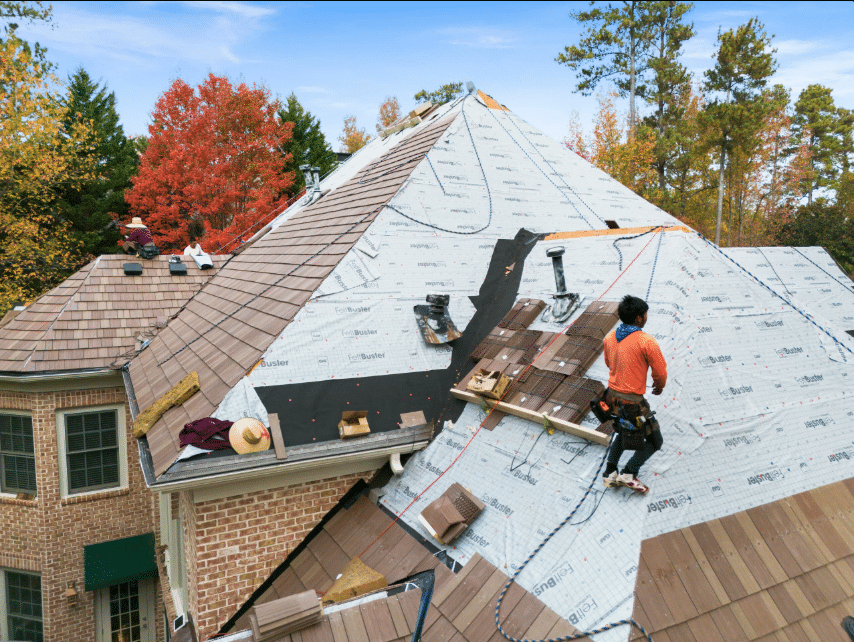
Composite roofs are designed to be extremely durable, but like any roofing system in Atlanta’s heat, humidity, and storm conditions, they still need occasional care. Routine maintenance helps protect their long lifespan and keeps them looking great year-round.
Common Composite Roof Repairs
Even though composite tiles resist cracking, warping, and rot, repairs may be needed for issues such as:
- Impact damage from falling limbs or severe hail
- Loose or lifted tiles/shingles caused by high winds
- Flashing deterioration around chimneys, walls, and valleys
- Gutter overflow damage that affects the roof edges
- Improper installation problems from previous contractors
Mr. Roofer’s team has more than 30 years of hands-on experience diagnosing these issues on synthetic shake, slate, and tile systems across Atlanta, Marietta, and Alpharetta.
Maintenance Tips for Composite Roofs
Composite roofing is low-maintenance, but regular inspections help prevent bigger problems:
- Annual roof inspections to check for lifted tiles, flashing gaps, or storm damage
- Gutter cleaning to keep water draining correctly and prevent rot at the edges
- Debris removal (branches, moss, and leaves) to protect shingle surfaces
- Professional attic checks to catch hidden moisture or ventilation problems
- Sealant and flashing tune-ups every few years for long-term watertight protection
A little maintenance goes a long way—especially in Georgia’s storm-heavy climate. If you notice leaks, stains, or missing pieces, Mr. Roofer can identify the issue quickly and make the right repair the first time.
Working With a Certified Composite Roof Contractor
Selecting the right composite roof contractor is one of the most important decisions a homeowner can make. Composite roofing systems are engineered products, and their long-term performance heavily depends on the skill of the installer.
For Atlanta, Marietta, Alpharetta, and surrounding areas, choosing a contractor who understands Georgia’s humidity, storm cycles, and local building codes is essential.
What to Look for in a Composite Roof Contractor
A qualified composite roofing installer should meet both professional and technical standards. This protects your home and ensures the roof performs to its full 40-50-year potential.
Key qualifications to look for:
- Proper licensing and insurance, protecting homeowners from liability, and ensuring the contractor meets state requirements.
- GAF Certified Plus or Master Elite credentials, which reflect advanced training, factory-approved installation practices, and eligibility for extended warranties.
- Strong reputation backed by online reviews, verified photos, and consistent workmanship.
Why local experience matters:
- Georgia’s climate is uniquely tough on roof materials, with high humidity, heavy summer storms, and intense UV exposure.
- A local composite roof contractor understands how these environmental factors affect shingles, underlayment, and ventilation systems, ensuring your roof is built for local conditions.
Benefits of Hiring a Local Expert
Working with a local roofing company offers advantages that national franchises can’t match, especially when it comes to speed, service, and familiarity with the community.
Key benefits of choosing a local composite roofing expert:
- Fast repairs and honest estimates from teams that are nearby and can respond quickly during storm season.
- Personalized service from roofers who know Alpharetta, Marietta, Atlanta, and North Georgia neighborhoods—their common roof styles, tree coverage levels, HOA requirements, and municipal codes.
Local experts also tend to build long-term relationships, meaning accountability and follow-up service remain consistent over the lifespan of your composite shingle roof.
Questions to Ask Your Composite Roof Installer
Asking the right questions helps homeowners compare contractors fairly and avoid hidden costs or substandard materials. These questions also clarify warranty obligations and installation methods.
Important questions to ask:
- What’s the warranty period? — Ensure both material and workmanship warranties are clearly outlined.
- Are the materials recyclable or impact-rated? — Many composite shingles have Class A fire ratings or Class 4 impact ratings; verify these details before installation.
- Does the estimate include tear-off and disposal? — Full pricing transparency prevents unexpected fees during the composite roof installation process.
Conclusion
A composite roof gives homeowners in Atlanta, Marietta, Alpharetta, and the surrounding areas a durable, stylish, and long-lasting alternative to traditional roofing materials.
With options that mimic slate, cedar shake, or tile, and performance features built to handle Georgia’s humidity, heat, and storms, it’s easy to see why more homeowners are upgrading to composite roofing systems.
If you’re considering a composite shingle roof installation, repair, or full replacement, working with an experienced local team ensures you get the best performance out of your roof. Mr. Roofer brings decades of craftsmanship, certified installation practices, and a reputation built on quality and honesty across North Georgia.
Book your free inspection or composite roof estimate today and see why homeowners trust Mr. Roofer for beautiful, reliable roofing that lasts.
